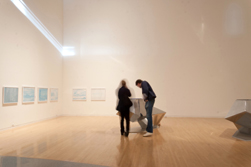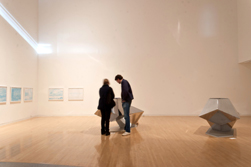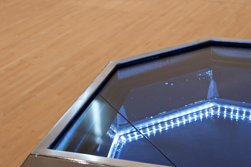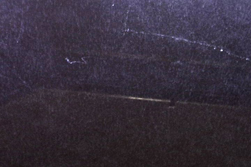Public Display Cloud Chamber
Our in the centre of the Elliott Lecture Wing was constructed at UVic as a collaboration between VISPA and artist , presently with her artistic practice and storefront based at in Brooklyn NY, previously in the Visual Arts department at UVic (she obtained tenure as a faculty member at UVic teaching and working here from 2002 - 2013). Engineer Mark Lenckowski, machinist Chris Secord, and electronics shop supervisor Neil Honkanen constructed the chamber. It uses a two-compression-stage refrigeration system that we designed in-house, and its cold plate runs continuously at a temperature of -80 C. It has a heated glass surface (indium-tin-oxide transparent resistive surface sandwiched in glass, made in Pennsylvania), and a continuous-flow pump for the alcohol. The project was scientifically led by , and artistically led by .
The Cloud Chamber went on public display beginning in January 2011. It started its public life on tour for 4 months as a featured exhibit at the Henry Art Gallery at the University of Washington in Seattle. We moved it back to Canada in May 2011, and it has been permanently installed in the Elliott lecture building here at UVic since September 2011, so students can see muons in between their classes.




The cloud chamber has its own website at . Lucy Pullen additionally maintains an excellent webpage for the chamber at , with many beautiful images and videos of the chamber there. (In fact, beautiful happens to be a perfect descriptor of every one of the images on Lucy's Cloud Chamber page that doesn't happen to also have Justin Albert within the image! ;)
Future displays include interactive signage for the cloud chamber, and may potentially also include radioactive sources that could occasionally extend out into the chamber from a "garage" within the side of the cloud chamber, a spark chamber suspended above the cloud chamber, a public outdoor projection of ATLAS real-time event display data on the outer wall of the Elliott building (facing the parking lot and Ring Rd.), small handheld rechargeable cloud chambers (that, like the main cloud chamber, would have internal refrigeration that would avoid any need to ever obtain or load dry ice [or other consumable coolants] into the chambers), and other ideas. Please contact Justin Albert and/or Dean Karlen if you are interested in helping with public displays or have additional ideas.
